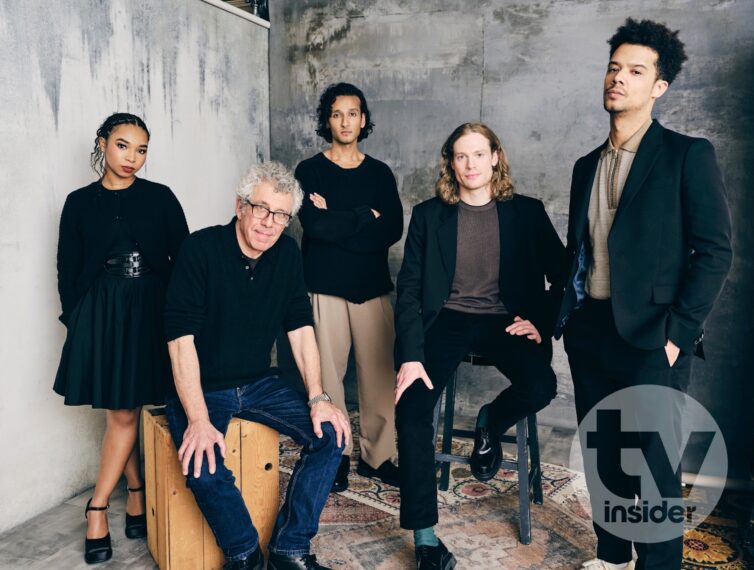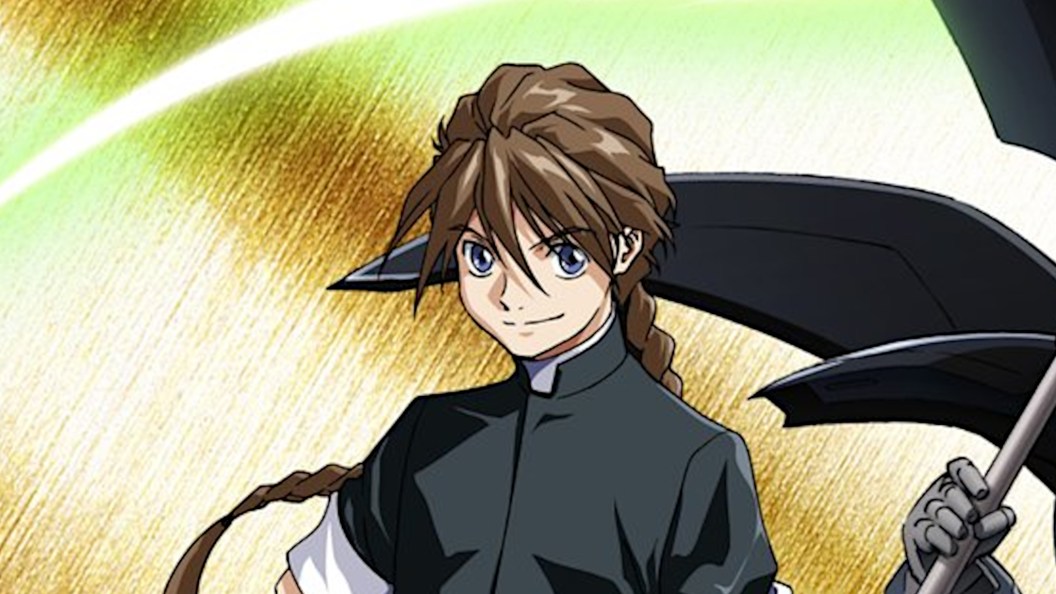AMC ‘s Interview With the Vampire only gets better with age. One of TV’s most confident shows has known exactly what story it’s telling since the very first episode, as proven in part by narrative seeds laid in Season 1 that wouldn’t come to fruition until the end of Season 2. Sam Reid joined us at the TV Insider office as part of the show’s FYC press tour to dissect Interview With the Vampire Season 2, as well as the surprise rockstar Lestat teaser debuted at San Diego Comic-Con 2024 just weeks after the series was renewed.
Reid says that teaser, which features the first original song from the upcoming musical season (“Long Face,” written by show composer Daniel Hart), was a chaotic “rehearsal” for Interview With the Vampire Season 3 — and also not their first go at the video. The Interview With the Vampire TV series is based on Anne Rice ‘s 1976 novel of the same name. Her story of the vampire Louis de Pointe du Lac recounting his immortal life to scrappy journalist Daniel Molloy in 1973 San Francisco popularized the humanized vampire in pop culture, serving as the blueprint for the modern vampire tales in media.

The series makes the titular vampire, played by the marvelous Jacob Anderson , a Black creole man living in 1910s New Orleans instead of a white plantation owner in the 18th century, in addition to other key changes — such as aging up select characters — to expand its narrative possibilities. In this universe, the 1973 interview from the book has already happened, but Louis invites the aged and ill Daniel ( Eric Bogosian ) to his Dubai penthouse for a redo after five decades of ruminating have left him wanting to set the record straight. In the first interview, Louis raked his former lover, Lestat (Sam Reid), across the coals.
The 2022 interview becomes a more nuanced portrait. Why exactly Louis is eager to repaint this tale is the mystery Daniel tries to solve, and he ultimately succeeds by the end of Season 2. At its core, the Interview With the Vampire story (be it the book, the 1994 film , or the series) is an exploration of the grief of losing a child through the lens of immortality.
Rice’s own daughter died at age 5 of leukemia; the first book was her processing her grief. Through Claudia, Rice created a child who would live forever, but even immortality isn’t a guarantee. What begins as a retelling of a toxic gothic romance horror story evolves into a tale of love, betrayal, loss, and self-actualization.
Vampirism is painted as a gift here rather than a curse, but Louis must process a century of unaddressed grief before he reaches that conclusion himself. When he does, it’s a transcendent end for the first two seasons that are two parts of a whole. Season 3, premiering in 2026, will be brand new territory as Lestat’s turn to tell his life story begins.
The beauty of AMC’s Interview With the Vampire is in the details. Have you noticed that in Season 1 Episode 3, when Daniel first questions Louis’ memory of a steamy tryst that that’s the first time we see Rashid/Armand ( Assad Zaman ) in the whole episode? The seemingly casual choice takes on new meaning when the depths of Armand’s involvement in the Paris trial and his mind control over Louis are revealed in the Season 2 finale. This episode also features the scene where Lestat uses his powers of mind control to make the soldiers leave his and Louis’ home, the importance of which also wasn’t revealed until Season 2’s end.
Season 1 is redefined by this expert narrative threading, showing that the writers (led by showrunner Rolin Jones and his laser-focused vision for this adaptation) have a grand plan in mind — and that they trust the intelligence of their audience to follow its deliciously dense dialogue on Louis’ “odyssey of recollection.” Few TV shows are so ready and eager to present such depth of detail for viewers to dissect. Part of the thrill is watching Louis do the same exact thing in his interview.
There’s even more fun to be had when the cast gets to do the dissecting with us. Sam Reid looks back on some of Interview With the Vampire Season 2’s biggest moments in the video interview above, starting with the haunting form his character took on this season. Dream-stat is a figment of Louis’ tormented mind and an extension of himself.
Louis and Lestat’s toxic relationship hit several breaking points in Part 1. Claudia ( Bailey Bass in Season 1, Delainey Hayles in Season 2) was a band-aid for an unhealthy marriage, one that ended for nearly a decade after Louis suffered brutal physical abuse from Lestat. Things were never really the same when they got back together.
Their collective misery led to Louis and Claudia plotting to kill Lestat, their maker. In Season 2, Louis is haunted not only by the possibility of Lestat surviving the murder attempt, but also by the fact that he so desperately hopes he did. Dream-stat appears out of Louis’ fear and loneliness as Claudia is icing him out during their search for more vampires in World War II Europe.
The basis for Dream-stat came from a passage in the second half of Rice’s novel. “It was as if the empty nights were made for thinking of him,” Louis says of Lestat in the book post-murder attempt. The writers took this and ran, but as Reid admits of the Dream-stat idea, “When I first read it, I was kind of pissed.
” Reid “didn’t think Lestat should be there at all really,” because this part of the story is specifically focused on Louis and Claudia’s relationship, as well as Louis and Armand’s. “I wasn’t really sure how this was going to work,” Reid says. The idea came into focus when he understood that Jones’ vision was all about Louis.
“We discovered that it was going to be a way for Louis to have a soliloquy, the way for Jacob to be able to get further into his internal dialogue so he could analyze himself,” Reid explains. Anderson and Reid worked together to develop the Dream-stat persona. They realized this was their chance to show “those softer, quieter moments” of Louis and Lestat’s relationship that Louis mostly withheld from Daniel, Reid shares.
The tender Dream-stat scenes were pieces of their relationship that Anderson and Reid knew existed in the subtext of Season 1 as well as in the happy moments actually depicted. It’s the scene in Season 2 Episode 4, where Louis imagines Lestat helping him review his photography, that “is the real key to that Dream-stat character,” Reid notes. “It’s about having somebody you trust and who you love to be able to show you your real self.
” There’s no “real” version of Lestat in the Season 2 Episode 3 flashbacks told through Armand’s point of view. Lestat’s first love, Nicki ( Joseph Potter ), is revealed in those 18th-century scenes. When asked what he and Potter wanted to make sure was clear about the Lestat-Nicki dynamic in the few minutes of screen time they had (as well as the Lestat-Armand bond with Zaman), Reid laughs as if excited that he was finally being asked this question.
“I don’t necessarily think that any real dynamic that is true was represented in Lestat and Nicki from what we saw,” The Newsreader star admits. It was more important to view this pairing from Armand’s perspective. The way Armand tells this backstory to Daniel reflects his “agenda,” as Jones previously told TV Insider .
“Whether or not [Armand’s version of this story] is true” is “up for debate,” Reid says with a knowing smile, but they “didn’t think it was valuable to portray the truth popping out from Armand’s point of view.” Not yet, at least. (Potter will be back in Season 3.
) “More importantly, these are characters that need to be put in line by Armand,” says Reid. The echo of the real Lestat is heard in the telepathic “call” with Armand in the show’s version of the 1973 interview, depicted in Season 2 Episode 5 — a standout episode for devoted fans and newcomers alike. Reid’s few lines could have easily been recorded through voiceover given Lestat’s physical absence in the episode, but Jones “gets very attached to the real thing,” the actor explains.
What you hear was recorded live just off-camera on Reid’s first day back at work (because of Bass’ sudden exit and Hayles’ quick casting, this Claudia-free episode was the first one filmed for Season 2 so Hayles could have more time to prepare). “It was valuable for Jacob and for Assad actually for me to be there to help with the flow of the scene,” Reid says of their ensemble, noting, “I wanted to redo it in ADR once I heard it, but Rolin was like, ‘No.'” As shared in their San Diego Comic-Con 2024 panel, Reid also wanted to redo his “Did you hurt yourself?” line from the Louis and Lestat reunion in Season 2’s finale, but Jones wants all feelings amplified.
In this world where vampirism heightens your emotions to the highest degree rather than stripping you of humanity, exaggerated and extravagant acting choices are not only encouraged but expected. The actors have full trust in Jones’ vision and that the writing, paired with Daniel Hart’s cinematic and deeply romantic score, will bleed together to justify the huge emotional swings. In the full video interview above, Reid shares what moves him so much about Claudia and Madeleine’s ( Roxane Duran ) romance, explains Lestat’s out-of-place apology in the devastating trial, and shares the personal significance of his and Anderson’s secret lines in the finale , as well as reveals details about how the rockstar Lestat teaser came to life.
The odyssey of recollection continues in Interview With the Vampire Season 3, which will mark a major stylistic shift as Lestat, now a world-famous rockstar, prepares to go on tour after Louis and Daniel’s book took the world by storm. Season 3 begins filming this summer in Toronto and will premiere in 2026. In the long nights between now and its return, there’s no better time to go back to Seasons 1 and 2 and let the tale seduce you (again).
Interview With the Vampire , Season 3 Premiere, 2026, AMC, Seasons 1-2 Available Now, AMC+ More Headlines:.
Entertainment

Sam Reid Explains ‘Interview With the Vampire’s Rockstar Lestat Teaser & Looks Back on Season 2 (VIDEO)

Plus, the rockstar Lestat teaser explained.















